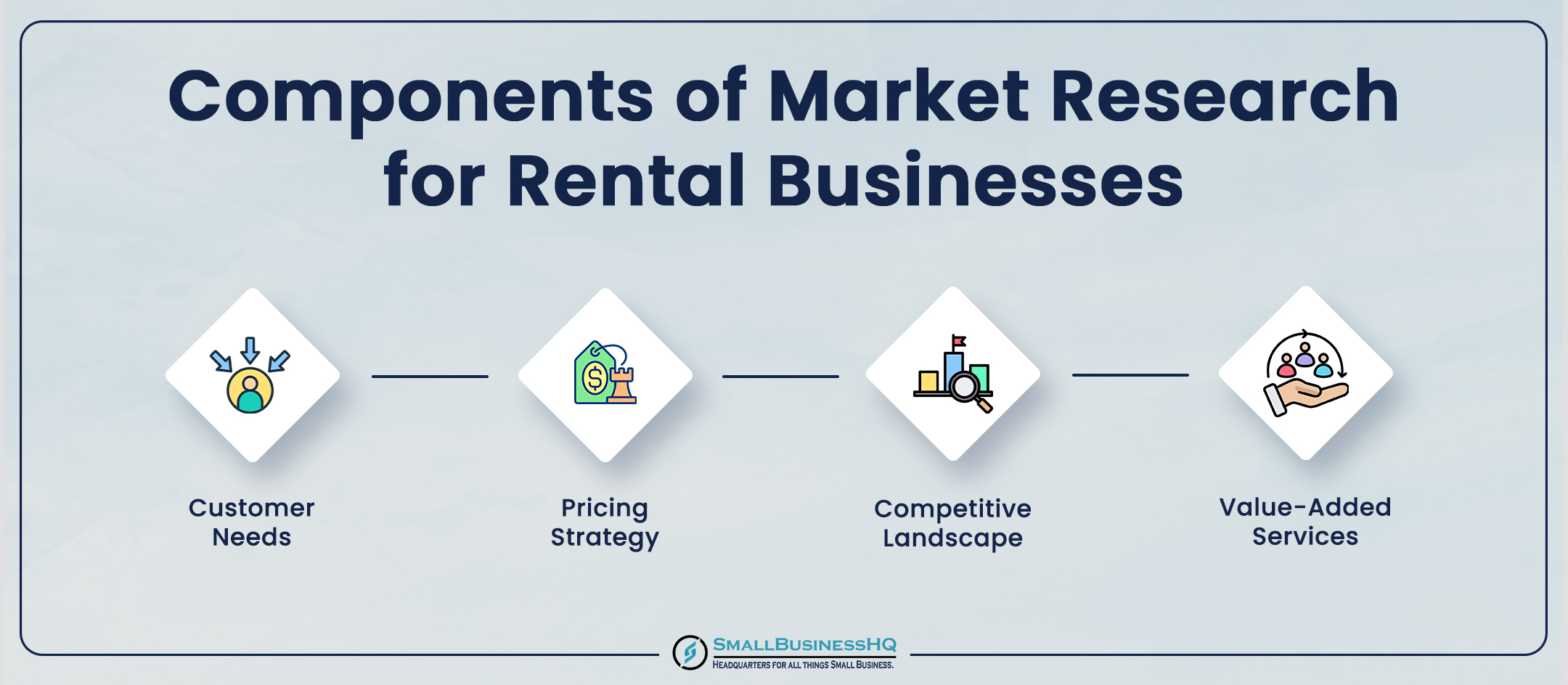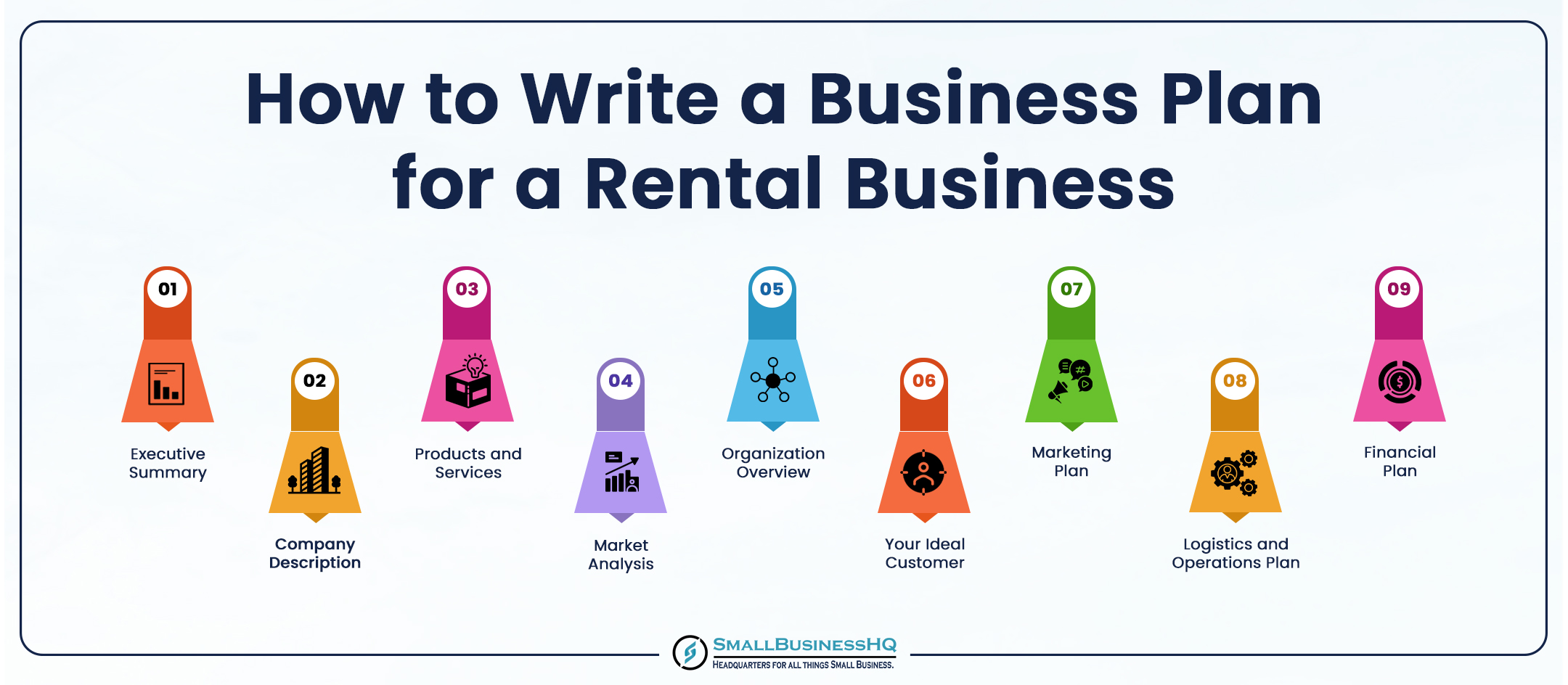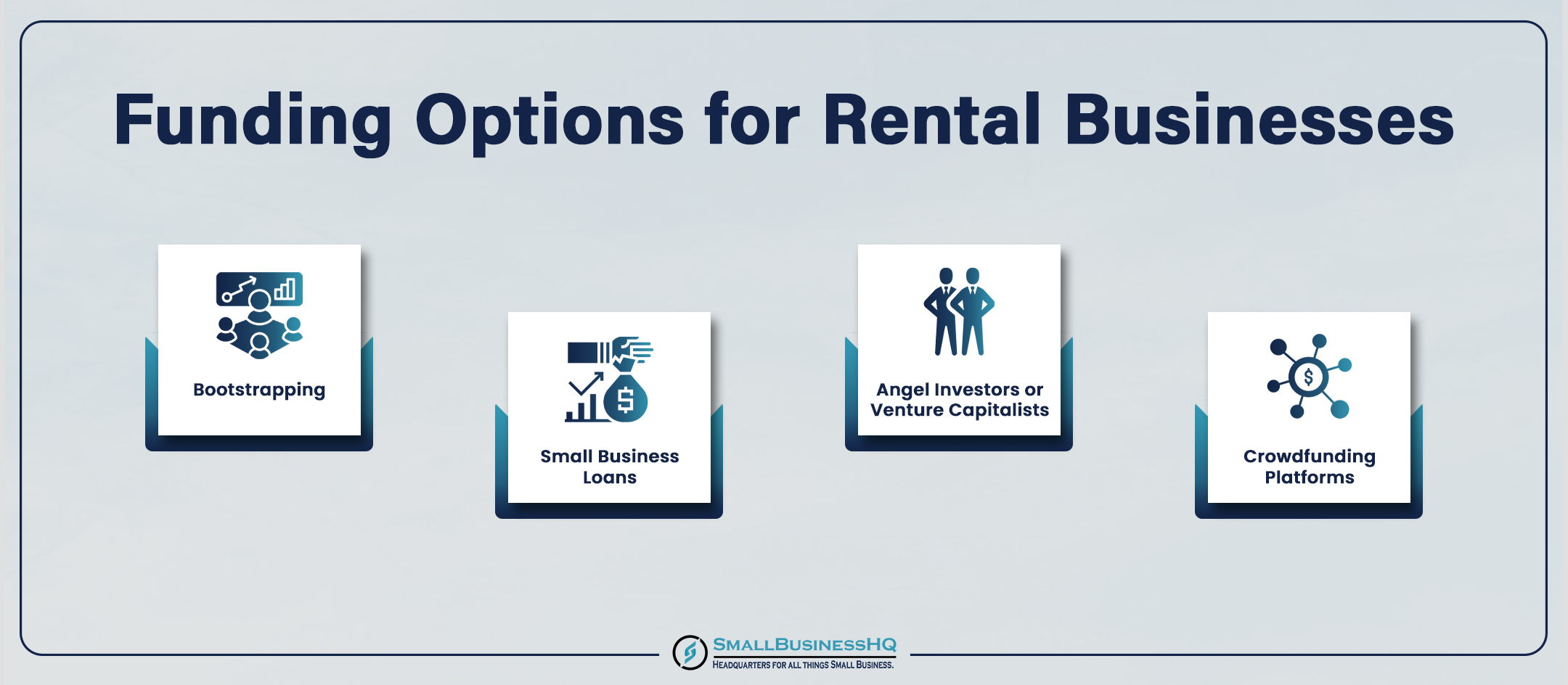Ownership is not always a requirement in the rental industry. Rental businesses provide customers with temporary access to items or assets.
Renting out properties, equipment, consumer products, and vehicles can be a lucrative venture. However, starting a rental business can be quite challenging.
You have to consider various aspects of the rental business. This includes asking questions like, What niche should I explore? What would be the required investment?
Answering these fundamental questions is critical when starting a business. This comprehensive guide details steps on how to start a rental business.
We’ll also discuss the major challenges of starting a rental business and how to overcome them.
Let’s get started.
A Step-by-Step Guide on How to Start a Rental Business in 2024
Our comprehensive guide is suitable for both seasoned entrepreneurs and beginners. This detailed guide will give you the knowledge and resources you need to confidently establish a successful rental business.
Step 1: Brainstorm Rental Business Ideas
Brainstorming is a powerful tool for generating innovative ideas when starting a new business. It is essential for gaining insights into launching a successful rental business.
It is crucial to have a clearly defined structure for optimal results in your brainstorming sessions.
When considering how to start a rental business, having a clear structure in mind can help align your interests and needs. It allows you to determine if a low-investment entrepreneurial venture with the flexibility to set your hours suits you.
Let’s explore ways to brainstorm rental business ideas and ignite your creativity.
- Personal Interests and Expertise: Discover what kind of product(s) you find particularly appealing. Starting a rental business is easier when you rent out items you have extensive knowledge about and have personally invested in.
- Look for Gaps in the Target Market: Identify what existing businesses in your target market provide. Identifying overlooked opportunities and bridging the gap between demand and supply is a valuable skill that can foster a business idea. You can step in and meet their needs by recognizing what people want and what’s currently available.
- Identify Customer Pain Points: Look for situations where people might be dissatisfied with their current options. For instance, someone plans a camping trip but doesn’t own a tent. However, it would be an unnecessary expense to buy a tent if they do not camp often. This frustration highlights a need for convenient and affordable tent rental services.
- Tap into Local Interests: Understanding your community’s hobbies and activities can be a gold mine for rental business ideas. Surveys or focus groups can provide valuable insights into popular local pastimes. For example, your local community is thriving with gardening enthusiasts. In that case, you might discover a high demand for rental equipment like tillers or aerators. However, most people wouldn’t use them frequently enough to warrant owning them.
Step 2: Market Validation and Analysis
After conceiving a product idea, prioritize market validation when starting a rental business. Market validation, also known as business validation, assesses the potential success of a product or service.
It helps to answer questions like, Will people pay to rent what you’re offering? Is there enough demand to make your business model profitable?
Taking this proactive business model approach helps you save valuable resources. It prevents you from investing time and money into rental businesses with a low chance of success.
More importantly, market validation builds confidence in your concept. Knowing there’s a place for your rental business in the marketplace gives you a solid foundation to move forward.
Step 3: Conduct Market Research and Feasibility Analysis
Thorough market research is a valuable tool that allows a business owner to gain deep insights into the wants and needs of their target customer.
Conducting market research helps you analyze the competition and identify your unique selling proposition (USP).
With this invaluable data, you can confidently dominate the market. It also helps you avoid costly mistakes and establish a stable foundation for your company’s future success.
Below are some key questions to answer through market research:

- Customer needs: What are your potential customers looking to rent? Are they seeking high-quality, brand-name rental equipment, or are they more focused on affordability? What specific features or functionalities are most important to these potential customers?
- Pricing strategy: How much are customers willing to pay for rentals of similar items? Consider the original purchase price of the products you plan to offer. Then, ensure your pricing is competitive yet reflects the value proposition.
- Competitive landscape: Who are your main competitors? Are you competing with established rental companies or retail stores offering similar products? Analyzing your competitors’ strengths and weaknesses will highlight opportunities for differentiation. It will also help you identify new equipment rental business ideas to try.
- Value-added services: Do your customers require additional services beyond just rentals? For example, can you offer delivery and pick-up options or sell complementary products like accessories or cleaning supplies? Identifying such opportunities can increase your average order value and improve customer convenience.
Step 4: Choose a Name and Domain
When making rental business decisions, selecting an ideal name and domain is just as crucial as identifying what to rent.
Selecting a name and domain for your equipment rental business is of utmost importance. It enables you to create a solid and memorable brand identity that reflects your offerings and values.
Here’s where creativity intersects with strategy:
- Memorable and Appealing: Your name should be catchy and easy to remember. It should also resonate with your target audience and reflect the rental experience you offer.
- Industry Standards: Research industry trends and naming conventions. Doing so helps you avoid potential conflicts with existing rental companies and possible misunderstandings.
- Availability Check: Don’t get discouraged if your initial equipment rental business idea has already been taken. Brainstorm a few options and verify domain availability to ensure you can successfully establish your desired online presence.
- Choose the right keywords: Having enough relevant keywords can significantly improve online visibility. It makes it easier for potential customers to discover your business. Consider the terms people would use to search for your rental services. For example, if you own a bike rental business, “bike rentals” or “rent a bike” would be good keywords.
- Local Focus: To attract customers in your area, use your city or region name and relevant keywords in your domain name and website content. For instance, “ChicagoPartyRentals.com” is clear and informative for local searches.
- Hyphens: Hyphens can be tricky. While they can help separate words in your domain name, they can also be easily mistyped or misunderstood when spoken. Fortunately, search engines like Google have become quite intelligent. They suggest the correct website, even when a hyphenated domain name is misspelled. So, if your rental business name has a hyphen and it’s memorable, go for it.
Step 5: Create a Business Plan
A clear understanding of your market helps you create a well-defined rental business plan.
Successfully starting a rental business requires a business plan that serves as your blueprint for success. This plan should clearly outline your goals, strategies, and financial projections.
A rental business plan does two critical things:
- Attract Investors and Partners: It showcases your company’s potential to potential investors and partners. It also explains your strategy, target market, and financial projections. This gives them a clear picture of your vision and how they could benefit from being involved.
- Guide Your Own Success: Creating a business plan requires thinking critically about your goals and strategies. Carefully analyzing all the details helps you better understand your rental business needs and the strategies necessary for achieving success. This clarity is essential for making smart decisions and navigating the challenges of running a rental business.
A complete and informative rental business plan is akin to having a comprehensive roadmap for a successful journey. It helps you and those who believe in your vision and might consider investing in your company’s future.
Incomplete or missing information can hinder your progress and disappoint those who support businesses like yours.
Are you feeling overwhelmed by the idea of creating a business plan? Rest assured, we are here to assist you. Starting a rental business plan might seem challenging, but you can simplify it by dividing it into clear and manageable steps.
Here are key sections to include in your rental business plan:

1. Executive Summary: This is a quick overview of your entire business plan. It highlights your company’s mission, target market, services, and financial goals. Imagine it as a captivating commercial for your business idea.
2. Company Description: Explain what makes your rental company unique and the value you offer to customers. Think of it as introducing yourself and your company’s personality.
3. Products and Services: List the equipment or property you plan to rent out. Will you specialize in a specific niche or offer various products and services?
Market Analysis: Here’s where you become a detective! Research your target market and identify who your ideal customers are. Also, discover their needs and preferences.
4. Organization Overview: Explain how you will structure your business. Who will be involved in running the day-to-day operations of your rental company? Do you plan to hire employees or manage things yourself?
5. Your Ideal Customer: This is all about getting to know your target audience. Who are you renting equipment to? Families, students, or professionals? Understanding your target audience’s demographics, wants, and needs helps you tailor your services and marketing strategy.
6. Marketing Plan: How will you get the word out about your rental company? Think social media, flyers, or local partnerships. This section outlines your strategy for attracting customers.
7. Logistics and Operations Plan: Explain how you’ll manage the rental process. Include all the details, from scheduling and bookings to equipment maintenance and returns.
8. Financial Plan: Outline your projected income and expenses. Include startup costs and potential revenue streams for future growth.
Another critical factor to consider when drafting your business plan is location. Unless your business model involves shipping rentals directly to customers, the physical location of your business can significantly impact its success.
For instance, starting a boat rental shop near a bustling tourist area will attract more walk-in traffic than a shop on the city’s outskirts. Therefore, your location will define your customer base. It will also influence how you receive bookings and manage operations.
Step 6: Finance Your Rental Business
Securing financing is one crucial aspect to consider when assessing how to start your own rental business. Finance directly impacts various elements of your business.
Understanding your options and their differences is crucial when launching a rental business to maximize profitability. You also need to consider funding and timeframes to scale your business.
Here’s a comprehensive analysis of several popular options. We’ll also discuss their advantages and factors to consider:

- Bootstrapping: This involves self-funding your own rental business using personal savings or the sale of assets. It offers complete ownership and control but can limit your initial growth potential.
- Small Business Loans: Banks, credit unions, and government agencies like the Small Business Administration (SBA) offer loan programs specifically designed for small businesses. These often require a strong credit score, a detailed business plan, and potential collateral.
- Angel Investors or Venture Capitalists: This route might be attractive for rental businesses with high growth potential, particularly those with a unique or disruptive concept. Angel investors are often wealthy individuals who invest in promising startups. In contrast, venture capitalists represent firms that pool capital from various investors. However, both options involve giving up some equity in your company in exchange for funding.
- Crowdfunding Platforms: There are online platforms that can allow you to raise capital from a large pool of micro-investors. This approach can effectively assess your concept’s market viability and create early buzz. However, reaching your funding goal can be challenging. It often requires a compelling campaign with clear rewards for backers.
Once you’ve chosen your funding path, be prepared to present a convincing case. When applying for loans, creating a comprehensive business plan with detailed financial projections is essential.
For example, if you currently own a home, you may have equity accumulated in the property that you can use to acquire more rental properties. A home equity loan allows you to borrow money based on the current value of the equity that you currently have in the property.
With a house valued at $350,000 and a remaining debt of $120,000, you have an equity of $230,000. This equity can be collateral for a home equity loan or line of credit. Certain home equity loans function as a revolving credit line you can access whenever you need money. Interest on a home equity loan is tax-deductible.
When approaching investors, highlight your unique selling proposition and growth potential. You can transform your rental business dream into a reality with a good plan and a clear understanding of your funding options.
Step 6: Set Up Your Rental Operations
This section provides valuable insights into the crucial yet often underestimated elements that drive the success of your rental business.
Establishing a solid operational foundation helps you streamline your processes and enhance customer satisfaction. This will help you save time and effort while creating a seamless and enjoyable experience for your customers.
Let’s discuss the crucial areas to consider when setting up rental operations:
- Inventory management system: According to a study, 46% of SMBs either use a manual system to track their inventory or do not monitor them. An inventory management system tracks your equipment, from availability and maintenance schedules to damage history. Rental inventory is crucial to your marketing efforts. It helps keep you organized, avoids double bookings, and ensures a seamless rental experience.
- Rental software: Rental software streamlines your operations. It automates repetitive tasks like reservation processing, online payments, and customer communication. It automates reminders and confirmations. This allows you and your team to dedicate time to more important responsibilities, such as providing excellent customer service and developing strategic plans. It also minimizes the risk of errors often associated with manual processes.
- Ironclad rental agreements: A rental agreement should include rental fees, damage deposit amounts to the renter’s responsibilities during possession of the item, and any late return penalties. A well-crafted rental agreement protects your equipment and sets clear expectations. It minimizes the potential for disputes and ensures a smooth rental experience.
- Customer Service: Responsive communication, prompt and professional resolution of issues, and friendly and helpful staff are the hallmarks of a positive customer experience. By prioritizing customer service, you build trust and positive customer relationships. This leads to positive word-of-mouth recommendations, encourages customers to buy from you, and ultimately boosts your overall reputation.
These core operational areas will establish a robust foundation for your new rental business. To establish a successful business, seek the expertise of professionals specializing in business formation services.
These experts ensure your legal registration is complete. They also guide you through acquiring an Employer Identification Number (EIN) and help you understand the specific licenses your business requires.
Step 7: Launch Your Rental Business Online
Today’s renters value convenience. Therefore, a robust online presence is essential when starting a new rental business.
A study shows that 67% prefer online bookings to save time, and 54% believe they can find better deals online in terms of selection and price.
If you have the skills to build a website independently, feel free to undertake the task. On the other hand, hiring an outsourced website developer will help you focus on other important tasks.
Before launching your online rental store, it is essential to have a solid grasp of Search Engine Optimization (SEO). SEO helps your website rank higher in search engine results, making it more discoverable by potential customers.
Crafting Your Brand Assets
You need to have a clear brand strategy before creating your brand assets. This strategy should include your brand’s purpose, vision, values, positioning, and target audience. It should also detail how your new rental business differs from other brands.
Your brand strategy should state how you build and convey your brand’s assets across various mediums and platforms.
Think of it as building a visual identity that encapsulates your company’s essence. When designing your brand identity, here are several elements to consider:
- Logo Design: A well-designed logo is the cornerstone of your brand’s identity. It should be visually appealing, recognizable, and consistent across all marketing materials.
- Social Media Presence: Establish profiles on relevant social media platforms to connect with your target audience. Use these platforms to showcase your inventory, share customer stories, and build brand awareness.
- Marketing Materials: This could include business cards and flyers, website design, and online advertising. Ensure consistency in your brand messaging, color scheme, and overall visual identity across all materials.
However, branding goes beyond visuals. It’s about creating a sense of trust and establishing yourself as a reliable solution within the rental market.
This understanding will guide your brand voice, messaging, and overall customer experience. It will help you create a strong brand that resonates with your target audience.
Build a User-Friendly Online Rental Store
Creating a visually appealing and functional website is no longer a tech wizard’s exclusive domain. Numerous website builder platforms cater to businesses of all sizes and budgets.
Here are crucial elements to consider when building your online rental store:
- Choose the right website builder: Select a platform that offers user-friendly features and integrates seamlessly with your chosen inventory management software.
- Compelling product descriptions: Crafting engaging descriptions highlighting the benefits and features of your rental items is essential to your business success. Use keywords relevant to frequent customer searches to enhance your SEO efforts further.
- High-quality product photography: Showcase your rental inventory with professional-looking photographs. Crisp visuals will capture customer attention and make your products appear trustworthy and desirable.
Online Booking
There are significant advantages to offering online bookings, especially for equipment rentals. They include the following:
- Convenience for customers: Eliminate the need for customers to visit your physical location or make phone calls. They can book rentals at their convenience.
- Advanced planning and reservation: Customers can plan events or projects. They can also secure the necessary rental equipment they need beforehand.
- Transparency and information access: Provide detailed product information on your website. Allow customers to easily compare features and pricing before making a booking decision.
Challenges Rental Businesses Face and Solutions
Managing a rental business can be incredibly rewarding. However, it also comes with its own set of hurdles. Let’s discuss three common challenges and solutions to help you build a profitable rental business.
1. Booking Juggling
Consider the inconvenience of managing the rental of kayaks, bikes, and camping gear. You have to know the different rates for each hourly, daily, or weekly rental.
Manually managing bookings and pricing structures can be a time-consuming task. Fortunately, there are online booking systems that you can utilize.
These platforms streamline the booking process by allowing you to:
- Offer Add-ons with Ease: Provide customers with a seamless experience by enabling them to easily include life jackets, helmets, or other gear in their rentals while booking.
- Pricing Made Simple: Create and manage different rental rates for various durations (hourly, daily, weekly). Also, set blocked-out times between rentals to avoid double bookings.
2: Equipment Maintenance
Whether you are in the bike rental business or rental property business, or you rent paddleboards or motorized fun like jet skis, maintaining your equipment is paramount. Safe, clean, and well-maintained gear ensures a positive customer experience and keeps you ahead of the competition.
The following will help you create a seamless customer experience in the equipment rental industry:
- Train Your Staff: Empower your team to identify equipment that needs attention before it becomes inoperable.
- Daily Checklists: Implement a daily checklist system to hold staff accountable for regular maintenance tasks.
- Tech to the Rescue: Consider online booking software that tracks past rentals and usage history. This helps you identify equipment that needs a closer inspection or replacement. Some software also allows you to take inventory offline for repairs, ensuring a smooth rental process even during repairs.
3: Inventory Mismanagement
Managing a large inventory can be quite challenging. Manual methods are prone to errors, resulting in overbooking or scrambling for missing items.
As mentioned earlier, rental software offers a powerful solution to manage your inventory efficiently. It helps you gain valuable insights and stay up to date with your rental equipment.
Here’s how rental software streamlines the inventory process:
- Barcode Scanning: Implement a barcode system to scan equipment at check-in and check-out, ensuring real-time inventory updates.
- Unique Identification: Assign unique IDs to each item for easy tracking and scanning.
- Low-Stock Alerts: Set low-stock thresholds in the software to receive automatic notifications when inventory reaches a minimum level. This allows you to plan for timely restocking and equipment purchases to avoid last-minute shortages.
FAQs
Q1. What is the most profitable thing to rent out?
There’s no universal answer to the most profitable rental. However, residential and commercial properties are generally known to be lucrative investments.
Q2. Is starting a rental business profitable?
Starting a rental business can be profitable, but success requires planning and effort. Consider factors like startup costs, ongoing maintenance, and finding good tenants.
Q3. What type of business is best for rental properties?
Residential and commercial rental properties are popular choices, but many other options exist. Consider vacation rentals, storage units, or renting out event spaces. The best rental property business depends on your resources and the local market.
Q4. What are some of the most hired items?
It can be pretty challenging to determine which items customers rent regularly. In the construction industry, for example, heavy equipment and power tools are in high demand by professionals and DIY enthusiasts.
Q5. Do equipment rental companies make money?
Equipment rental business can be profitable. The key is to manage their inventory wisely and set competitive rental rates. Keeping the equipment well-maintained and in demand can generate a steady income stream.
Final Thoughts: How to Start a Rental Business?
The rental industry is experiencing significant growth, making it an ideal time to start your own rental business. This comprehensive guide provides the knowledge and resources to start a rental business.
Brainstorm niche ideas, build a user-friendly website, and implement effective marketing strategies. Also, attend industry conferences, join online rental business communities, and consult with business mentors.
Your rental business can become a successful and sustainable venture with dedication, the right rental business idea, strategic planning, and a commitment to customer satisfaction.
Understanding your target audience, offering exceptional customer service, and consistently exceeding expectations are crucial to success.
So, what are you waiting for? Start building your own rental business today.











